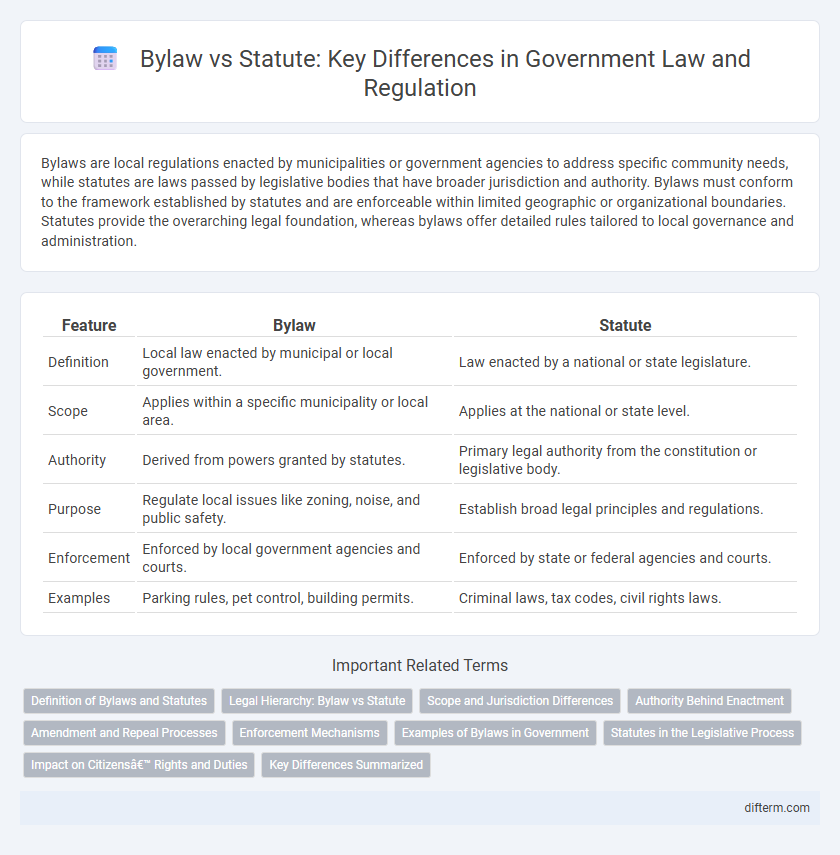Bylaws are local regulations enacted by municipalities or government agencies to address specific community needs, while statutes are laws passed by legislative bodies that have broader jurisdiction and authority. Bylaws must conform to the framework established by statutes and are enforceable within limited geographic or organizational boundaries. Statutes provide the overarching legal foundation, whereas bylaws offer detailed rules tailored to local governance and administration.
Table of Comparison
| Feature | Bylaw | Statute |
|---|---|---|
| Definition | Local law enacted by municipal or local government. | Law enacted by a national or state legislature. |
| Scope | Applies within a specific municipality or local area. | Applies at the national or state level. |
| Authority | Derived from powers granted by statutes. | Primary legal authority from the constitution or legislative body. |
| Purpose | Regulate local issues like zoning, noise, and public safety. | Establish broad legal principles and regulations. |
| Enforcement | Enforced by local government agencies and courts. | Enforced by state or federal agencies and courts. |
| Examples | Parking rules, pet control, building permits. | Criminal laws, tax codes, civil rights laws. |
Definition of Bylaws and Statutes
Bylaws are internal rules adopted by organizations or municipalities to regulate their own operations and governance, often addressing administrative details and procedural matters. Statutes are formal laws enacted by legislative bodies, such as parliaments or congresses, that establish legal standards and obligations applicable to the public at large. Both serve as frameworks for governance, but statutes carry broader authority and legal enforceability compared to the more specific and localized scope of bylaws.
Legal Hierarchy: Bylaw vs Statute
Statutes hold a higher position within the legal hierarchy compared to bylaws, as they are enacted by legislative bodies such as parliaments or congresses and establish broad legal frameworks. Bylaws are subordinate rules created by organizations or local governments to regulate specific activities within their jurisdiction, provided they do not conflict with existing statutes. Compliance with statutes is mandatory, and any bylaw conflicting with a statute is typically deemed invalid or unenforceable.
Scope and Jurisdiction Differences
Bylaws are local rules enacted by municipal governments or organizations, governing specific areas such as zoning, property maintenance, or community conduct within their jurisdiction. Statutes are laws passed by higher legislative bodies like state or federal governments, with broad application that overrides local bylaws when conflicts arise. The scope of statutes is generally wider, encompassing statewide or national issues, whereas bylaws have limited jurisdiction and address localized regulatory needs.
Authority Behind Enactment
Bylaws derive their authority from a parent statute or government entity, enabling local governments or organizations to regulate specific issues within their jurisdiction. Statutes are primary laws enacted directly by a legislative body, such as a parliament or congress, establishing broad legal principles and frameworks. The authority behind statutes is constitutionally grounded, granting them precedence over bylaws in the legal hierarchy.
Amendment and Repeal Processes
Bylaws undergo amendment or repeal through a process typically involving the governing body's approval, which may require a majority vote or special quorum, ensuring flexibility and responsiveness at the local level. Statutes, however, demand a more rigorous legislative procedure for amendment or repeal, often requiring multiple readings, committee reviews, and executive assent, reflecting their broader legal significance. The distinction in these processes emphasizes the adaptability of bylaws compared to the formal, structured nature of statute modification.
Enforcement Mechanisms
Bylaws are typically enforced through local government authorities and can include fines or penalties specific to municipal regulations, while statutes carry broader legal authority enforced by higher governmental bodies such as state or federal agencies with more substantial penalties including imprisonment. Enforcement of statutes often involves court systems and formal legal proceedings, whereas bylaws may be handled administratively or through municipal courts. The distinct enforcement mechanisms reflect the scope and jurisdictional reach of bylaws versus statutes within governmental frameworks.
Examples of Bylaws in Government
Bylaws in government often regulate local matters such as zoning laws, noise control, and public park usage, enabling municipalities to address community-specific issues effectively. Examples include city council bylaws that set building codes or restrict hours for commercial operations. These bylaws operate under the authority granted by statutes or higher government laws, ensuring localized governance within legal frameworks.
Statutes in the Legislative Process
Statutes are formal laws enacted by legislative bodies such as parliaments or congresses, serving as primary instruments in the legislative process to establish legal frameworks and public policies. These statutes undergo rigorous drafting, debate, and approval stages before being codified, ensuring comprehensive regulation and governance across jurisdictions. Unlike bylaws, statutes possess broader authority and must comply with constitutional provisions, impacting wide-ranging sectors from criminal justice to environmental protection.
Impact on Citizens’ Rights and Duties
Bylaws regulate local matters and directly affect citizens' day-to-day responsibilities, such as property use and community behavior, while statutes established by higher government authorities set broader legal standards and protections impacting fundamental rights and obligations. Citizens must comply with bylaws to avoid penalties in municipal contexts, whereas statutes determine essential legal frameworks like civil rights, criminal laws, and public welfare provisions. Understanding the distinction between these legal instruments helps citizens recognize their rights and duties within different governmental layers.
Key Differences Summarized
Bylaws are rules enacted by local governments or corporations to regulate internal affairs, while statutes are laws passed by legislative bodies that apply broadly across jurisdictions. Bylaws typically have a narrower scope, addressing specific organizational or municipal needs, whereas statutes provide general legal frameworks enforceable by courts. Enforcement mechanisms and legislative authority differ, with statutes holding higher legal precedence over bylaws.
bylaw vs statute Infographic

 difterm.com
difterm.com